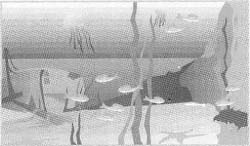The Great Barrier Reef

A
The Great Barrier Reef boasts over 2,800 coral reefs and a diversity of species only rivalled by tropical rainforests. However, in recent decades, just like the rainforests, reefs and their inhabitants have been declining drastically in number. Although natural factors such as predators, cyclones and disease have always had an effect on marine wildlife and habitats, human actions need to shoulder most of the blame for this destruction.
B
Fishing is one such action which is directly and indirectly harming marine wildlife population numbers. The setting of nets accounts for the death of turtles, dugongs, whales and dolphins. Turtles, for example, can hold their breath for up to an hour, however, if they get caught in a trawl net from a trawler, their oxygen is usually depleted within 15 minutes as it is an enforced submergence. Dugongs, on the other hand, can only hold their breath for a maximum of 8 minutes so once they become entangled in certain types of mesh nets, they drown. Shark nets (nets set to catch sharks near bathing areas) have also been responsible for the death of more than 4,000 turtles, 500 dugongs and 700 whales and dolphins since the Queensland Shark Control Programme commenced in 1962 at many Queensland beaches. Fish netting and illegal hunting are the biggest contributors to the degradation of marine wildlife. However, it is difficult to estimate the extent to which illegal activities adversely affect marine wildlife populations.
C
All vessels, including commercial ships, fishing vessels, and recreational craft endanger marine wildlife. The increasing number of high-speed vessels operating in reef waters frequented by marine wildlife increases the risk of collisions, which often result in death or injury. Vessels may also scare marine wildlife from their feeding areas or disrupt social bonds in populations. In some circumstances, stress is suspected of contributing to illnesses in dugongs.
D
While fishing and boating mainly cause harm to the marine wildlife, coastal development is a major threat to the coral reefs. An increasing number of seaside wetlands along northeastern Australia’s coastal plain have been replaced by croplands and development. These wetlands are the natural filters of fresh water coming from the continent. Deforestation, overgrazing by livestock, and run-off from towns, farms, and industries upstream result in more sediments and nutrients flowing out towards the Great Barrier Reef. The total has quadrupled since colonial times. Corals can endure in surprisingly murky water provided that sediments can be periodically swept off by tides and currents. However, it is the nutrients that actually wreck the reef. Anything beyond moderate levels of nitrogen hurts maturation and reproduction in corals.
E
The dumping of garbage is prohibited inside the Great Barrier Reef Marine Park. Yet, increasing amounts of debris, such as plastic objects and fishing line, enter the marine environment every year. The consequences of these thoughtless actions can mean that turtles can entangle themselves in discarded lines or even mistakenly ingest plastic bags as food. A small number of turtles die or float ashore on Queensland beaches every year as a result of this. Furthermore, debris on nesting beaches can also cause harm or even death to a turtle. Such refuse interferes with a turtle’s ability to dig an egg chamber and deposit eggs and may prevent hatchlings from reaching the sea. Turtles are not the only victims of this garbage; in 2000 a large rare Bryde’s whale died near Cairns and when examined, its stomach was compacted with plastic sheets, bait bags, zip top bags, fertiliser bags, several metres of plastic strips, supermarket bags and frayed rope pieces.
F
Apart from the man-made destruction of the Great Barrier Reef, the natural environment has also played a role. For instance, the crown of thorns sea stars, armed with poison spikes and an appetite for hard coral, can kill a reef. By projecting their stomachs out of their mouths and wrapping them around coral, they slowly devour it. These days they are out in force, which means the reef is being eaten more quickly with each passing day. While some believe that they are part of a natural cycle, like wildfires, others think that humans have caused the outbreaks by the overflshing of species that cull juvenile crown of thorns sea stars. Nevertheless, it has reached the epidemic stage and although some divers are trained to kill them, there is no large-scale weapon against the sea stars. Conservationists simply watch and wait, hoping that afflicted areas will make a recovery.
G
Finally, global warming also threatens the Great Barrier Reef. Abnormally high ocean temperatures, inflows of fresh water, high ultraviolet radiation, and changes in salinity cause bleaching in coral. That is to say, when stressed, corals expel algae that live in their transparent outer tissues, exposing the corals’ limestone skeletons. Bleached coral is not necessarily dead coral though, it often regains its healthy colour when conditions return to normal. However, prolonged bleaching can lead to coral’s death. This is just one more way global warming and periodic climate shifts such as El
 can change the face of the Earth.
can change the face of the Earth.
H
A great deal of the reef and wildlife can be saved. Along with conservationists, the Great Barrier Reef Marine Park Authority needs the support of all citizens to provide for the protection, wise use, understanding and enjoyment of the Great Barrier Reef in perpetuity.
Increased boating


 can change the face of the Earth.
can change the face of the Earth.